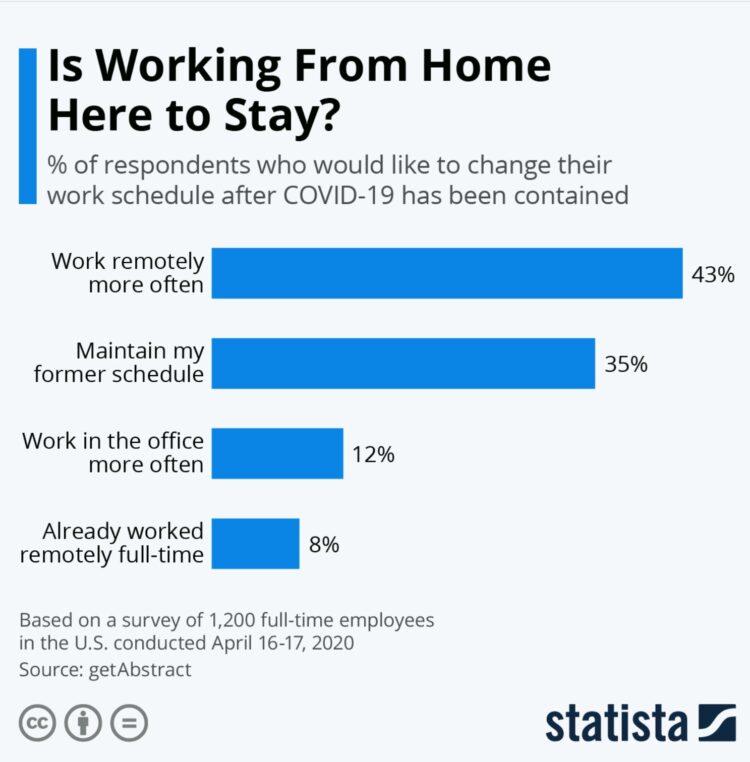
In a post-Covid corporate era, the new world of remote employment has begun to dominate the working landscape, transforming the 9-5 as we once knew it into a new digitally connected future. As more corporate workers begin to swap the office chair for their comfy couch, this brave new way of working is still in its trial stages, full of teething issues and horrendously terrible wifi connections.
As more businesses turn to a future of working from home, it’s imperative that the transition is carried out effectively in order to preserve staff wellbeing and productivity and in turn the success of the company.
In a recent study conducted by getAbstract, 43% of corporate employees opted to work remotely in the future, compared to only 12% itching to return to the office. As working attitudes amongst staff members continue to shift in the wake of the pandemic, it’s no surprise that many businesses are beginning to follow suit and adopt a more permanent remote future.
Adopting new remote management skills, online internal comms channels and ergonomic work aids are just a few of the ways business leaders can guarantee a smooth transition from the office to the home. If you’re looking to switch up your company’s working environment to follow the current trends, you need to be prepared to embrace new leadership techniques for a positive outcome.

What Are The Impacts Of Going Remote?
Going fully remote has both its advantages and its drawbacks. Positives such as a flexible working schedule and the money saved on office rentals can easily make the shift appear idyllic, but those swapping the commute for the couch are still learning to adapt to more isolating working conditions.
Flexibility
It’s no surprise that one of the benefits of working from home is schedule flexibility. For employers of deadline-based practices such as marketing and business, flexibility is key to help enhance employee productivity and deadline success.
One of the positives of embracing a remote working landscape is that colleagues can not only effectively manage their work around their personal life but actually dedicate more time to their position. Without the dread of the Monday morning commute and a set 9-5 working day, many businesses find that with the freedom to adjust their schedule to fit them, staff are more likely to be productive and innovative while working from home.

Cost Cutting
If your field of work allows it, remote working conditions can also greatly cut costs for business owners. A study by Global Workplace Analytics found that 6 in 10 employers saw a reduction in workplace expenses after switching to remote work full time. From office rent to food and beverages, business leaders are able to save money on basic office supplies and staff needs by switching the workplace for the virtual alternative.
Another cost heavy benefit of switching to a work from home future is the impact on business tax. With three defining factors determining a company’s tax burden, removing property costs and accommodating remote workers can reduce tax expenses and leave a larger budget for both payroll and company sales tax.
By cutting workplace costs in a new remote future, company leaders are able to invest increased profits in high-tech company equipment for efficient remote production, state of the art systems and communications channels for improved internal comms and even new members of staff to further expand the workforce for increased production levels.
Mental Health
Posing as an often a silent ramification of working from home, employee wellbeing and mental health are easily forgotten during a remote workplace shift. As more corporate workers from ever are now forced to work within their own four walls, lockdown restrictions, workplace isolation and loneliness are common amongst an adapting remote workforce.
A report by Lloyd’s Register in 2024 stated that 69% of employees globally reported higher levels of work-related anxiety and stress while working from home, driven by major changes to their 9-5 environment and loss of structure in their daily schedules.
Without the correct support, many companies could see a negative impact in terms of work progression and company success as colleagues fall into unhealthy working patterns and lack motivation. Therefore, it has never been more important for business leaders to manage a virtual working transition effectively in order to not only maintain high business standards but the physical and mental wellbeing of the employees that drive that success.
How Can Businesses Manage The Transition?
Effectively managing the transition from the office to a virtual working landscape is imperative if you want to see success. In the wake of Covid-19, it’s not uncommon for businesses to be considering a remote future for their employees, making it all the more important to improve the move. If you’re looking to cancel the commute and embrace the WFH future, here are some business-boosting hacks that will help your company transition with ease.
Stay Connected
In order to maintain a successful virtual team, staying connected is the most important obstacle to overcome during the transition. Ensuring that colleagues are able to effectively reach each other through online channels is vital in order to maintain a productive and successful workforce. From Zoom conference calls to Slack messenger communication, investing in virtual internal comms improves team building and morale.
As well as significantly reducing loneliness and symptoms of poor mental wellbeing, maintaining communication leads to a higher work production success rate as team members are able to plan, collaborate and ask questions about projects and deadlines with a quick and easy response system. By mirroring the communication system that would be practised in the office, employees feel as if they have a definitive working structure and more support.
According to a recent poll conducted by Statista, there has been a 40% increase in downloads of business apps between January 2024 and April 2024, spiking as the corporate landscape entered its first remote lockdown. As downloads continue to rise at a steady pace, it’s time your company hopped onto the virtual wave and enjoy that Friday Zoom call quiz!

Maintain A Strong Virtual HR Team
Sustaining a dedicated HR team is an essential necessity to ensure an office environment runs smoothly. Whether this comes in the form of virtual or face-face support, building a strong team of HR professionals can lead to a happier workforce, as employees feel supported and appreciated during the working week.
In a post-pandemic era where both mental and physical wellbeing has been affected by Covid-19, maintaining a strong connection between HR and remote colleagues is imperative to ensure that staff health and wellbeing is protected. In a 2024 report by the UK’s Office of National Statistics, 53% of remote workers claimed that they were worried about the impact of the virus on their wellbeing. Therefore, as many corporate workers continue to be thrown into a new world of work in the midst of a global pandemic, businesses need to provide higher levels of ongoing support to reduce employee absenteeism and lower their work-related stress.
Simply improving employee-HR relationships is the easiest step to take towards a healthier workforce. For virtually connected staff members, scheduling one-one video calls, online stress management workshops and maintaining ergonomic wellbeing will vastly improve the WFH experience. For instance, with 2.2 billion people that have some form of blindness or vision impairment, providing adequate support for your employees’ eye health is a must for an employer. Whether it’s through protective equipment (like monitors with blue light filters or glasses, which you can shop online on this website), eye health package (e.g. insurance) or at least paid-for, regular check-ups to make it easier for employees to monitor their eye health and make timely corrections, when needed.

Improve Leadership Techniques
As the team moves further apart geographically, maintaining strong leadership can be challenging in a new remote landscape. Embracing new behaviours is essential going forward as in-office styles of leadership are unfortunately redundant when working from home.
As a virtual leader, it’s time to swap that closed office door for an open one online. Allowing your employees to maintain good communication with you and reach you across a number of channels is vital in order to achieve success. As the days of knocking on the manager’s door are slipping away, colleagues need to be able to easily seek advice and a sign-off from you in order to keep projects moving at an efficient speed.
For both hybrid and solely virtual company structures, leaders also need to embrace innovation and inspiration when it comes to successful management. As the boss, it’s your job to boost morale, provide stability and cheer your team on as they continue to adapt.
Making use of popular internal comms channels such as Zoom and Slack, start and lead conversations both personally and professionally and encourage virtual employees to engage in regular interactions. For a strong and tight-knit team environment, it’s important that you use your platform to improve both communication and collaboration.
Managing The Future
As predicted by a recent Upwork survey, 1 in 4 Americans will be working remotely in 2024. In a post-pandemic era of corporate work, it’s safe to say that the 9-5 stability is up in the air as new flexible working conditions continue to evolve. In terms of managing a future of work from home employment, it’s time for business leaders to step up and transform their virtual transition. By adopting new leadership techniques, virtual internal communications channels and a strong HR & Wellbeing team, watch your business flourish, expand and reach peak WFH success.













